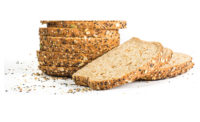Chocolate is more ubiquitous than ever. You can find a chocolate-flavored version of just about any snack or bakery product. But successfully incorporating chocolate into a product requires careful ingredient selection from the broad array of chocolate ingredients offered by suppliers. Ever-evolving consumer preferences have also prompted chocolate manufacturers to innovate around sourcing and health.
Coating options
Chocolate has a regulated standard of identity. Products that do not meet this standard cannot be labeled as chocolate. “Chocolate is made from cocoa ingredients,” says Bonnie Domingo, director of R&D, Kerry, Beloit, WI, “including cocoa butter, cocoa, chocolate liquor.” Chocolate-type products that do not conform to this standard—compound or confectionary coatings—have more flexibility, made with sugar, vegetable fat, cocoa, emulsifiers and flavors. “The main difference between compound coatings and chocolate is the source of fat—vegetable fat versus cocoa butter,” she says.
Compound coatings are more versatile than chocolate. “Compounds can be used in an ambient cereal bar or a thin coating for dipping ice cream bars,” says Zachary Freed, customer innovation applications specialist, confectionary, AAK USA, Inc., Newark, NJ. “Plant-based fats used in compound in are generally less expensive than cocoa butter, which makes compounds a more cost-effective alternative to pure chocolate. The wide variety of plant-based fats available allow for many applications where compounds perform better than pure chocolate. For example, in freeze/thaw, pure chocolate would not be the best option due to hardness and bloom. In high-temperature environments, cocoa butter would melt, and in fillings cocoa butter would be too firm. The biggest challenge in using a compound coating is if the customer wants an exact flavor or texture match to pure chocolate.”
Another benefit of compound coatings is the ability to meet a specific need by modifying the melt point, notes Katy Cole, technical service manager, Cargill Cocoa & Chocolate, Lititz, PA. “Compound coatings can be developed with higher melt points to mitigate the oil migration between core and coating, or mitigate (not eliminate) effects of heat during distribution. Bar applications typically use compound coatings with melt points ranging from 94o to 108oF. Some snack cake and doughnut manufacturers use coatings with melt points of 112oF. The one drawback of higher melt point coatings is an increase in waxiness and a decrease in flavor release.”
Sustainability moves
Consumers have a growing awareness of the environmental impacts of their food. Because chocolate is grown in tropical regions that can be environmentally fragile, people are seeking more information around the sustainability and ethical harvesting of chocolate. Jacques Boudreau, vice president of sales, Kerry, notes that per Mintel GNPD, new chocolate confectionary products with environmental and ethical claims were up 43 percent in 2016 vs 2015.
Many suppliers have become more intimately involved in the sourcing of their products. “Kerry offers a portfolio of Simply Nature products that bring together our worldwide network of farmers, growers, researchers and scientists whose deep knowledge allows us to extract the purest possible tastes from the most sustainable sources,” says Boudreau.
Chicago-based Blommer Chocolate’s sustainability program focuses on improving the business model of cocoa farming through the use of improved farming techniques and providing access to better-yielding plant material and access to farm inputs, says Stacey Kidd, marketing communications manager. The program also focuses on the community. “Our Sustainable Origins program works to address the challenges in farming communities. We facilitate the construction of schools, medical centers and wells for access to clean drinking water. Gender empowerment is addressed through women’s agricultural training in developing alternative crops for diversified income and additional food security for the farming family.”
Sustainability also factors into compound coatings. Dennis Tagarelli, senior director of sales, AAK USA, notes that AAK was a founding member of RSPO, the Roundtable on Sustainable Palm Oil. “The RSPO’s vision is to transform the industry to make sustainable palm oil the norm. The RSPO created a set of global principles and criteria which allows for palm oil to be certified as sustainable and for all stakeholders in the supply chain to handle certified oil.”
Latest trends
“Protein continues to drive snacking choices, yet satisfying a craving is the number one reason people snack,” says Shawna Pocock, vice president of sales, Kerry. “We see that consumers are trying to marry the two together. Coating protein pieces in chocolate and compounds is a great solution that delivers on this consumer demand.” Kerry offers chocolate-coated and compound-coated nuts, as well as roasted legumes like edamame and chickpeas. “These can also be coated with chocolate and peanut butter compounds to create a fantastic and satisfying snack.”
Marret Arfsten, product line manager, Cargill, Minneapolis, also points toward the protein-enriched food boom. “The focus is now on satiety rather than sports recovery, with chocolate as the No. 1 flavor choice for protein products,” she says. “Additionally, fruits and vegetables are increasingly being included in chocolate products, adding a healthy and fresh dimension. Traditional carrot cakes are giving way to new combinations, including kale-flavored fillings and chocolate cake featuring beetroot.”
Snack and bakery products are also benefiting from textural diversity. “Multi-textural is in,” says Rose Potts, corporate manager, sensory and product guidance, Blommer. “Make it crunchy, or make it smooth and creamy, or preferably both! We are seeing complicated textures, flavors that really meld the chocolate—bakery and snack. Chocolate can hold crazy creations together and can be part of the smooth and creamy, melt-in-your-mouth to contrast with the crunchy, salty snack or the crunchy cookie center. We see the marriage of chocolate and popcorn driving the sales of ready-to-eat popcorn up 17 percent. Chocolate raises the bar when a part of the snack or bakery item, making the perception of that item more indulgent and worth the treat.”
Arfsten cites an increased level of artistry. “Today’s food world is looking brighter than ever,” she says. “Plates are becoming more artistic. In coatings and fillings, the possibilities to play with color are endless—from bright, rich or pastel colors to shimmering hues that really catch the eye. With the increasing trend for black and white products, cocoa powder also offers opportunities to play with shade and depth of color.”
Freed recommends following the lead of food-focused consumers. “According to Mintel, 47 percent of U.S. consumers consider themselves ‘foodies,’ sparking creative combinations such as blood orange milk chocolate with Hawaiian Alaea red sea salt. Smoke and alcohol flavorings have found their way into the chocolate category, along with an uptick in more classic coffee/espresso combinations.”
Clean and clear labels are also in. Cathy Fichtner, category manager, chocolate and cocoa, Global Organics, Cambridge, MA, reports organic chocolate and cocoa are increasingly in demand as consumers are looking for clean-label products. “Organic cocoa ingredients are produced without the use of toxic and persistent pesticides and synthetic fertilizers. Organic farmers protect and nurture the earth’s resources, such as soil and water.”
The next wave
Some chocolate suppliers are continuing to expand their efforts around sourcing, using this as a way to market their uniqueness of their product. Boudreau notes that named provenance is a growing trend. “Consumers have a growing desire to know where their food comes from. In Europe, there is a greater variety of vegan and lactose-free chocolate products available to consumers.”
Blommer has innovated in the ultra-premium market space and recently launched a “Founder’s Reserve” line. “These chocolates have been formulated with the most select ingredients, slow crafted with special conching and refined to deliver exquisite melt, creating an indulgent experience,” says Potts. “The premium market has been growing, and we saw a need to create these unique and incredibly decadent products.”
Tagarelli sees the growth of health-conscious consumers influencing the industry. “According to Mintel, 48 percent of Canadian chocolate consumers say they would like to see chocolate offerings with more health benefits, and 17 percent of U.S. chocolate buyers cite health as playing a role in their purchasing decisions.”
In response to this trend, producers have promoted chocolate’s health benefits and focused on high-quality ingredients. Suppliers have also developed chocolate ingredients with reduced sugar and high cocoa content, as well as blended milk-dark offerings.
One example is Blommer’s Wonder Line of lower-fat compound coatings. According to Jenna Derhammer, applications and innovations manager, the line uses an exclusive fat-replacement technology that allows for reduced-calorie and reduced-fat coatings that taste delicious. “We believe this disruptive technology is going to be a game-changer for our customers who will now be able to reduce fat and calories without sacrificing decadence.”
Global Organics has found an exciting approach to merge the desire for clean-label, fair-trade sourcing and health benefits. The company recently introduced a fair-trade organic dark 48 percent chocolate chip made with coconut sugar. “This chocolate was introduced as a low-glycemic option to chocolate made with cane sugar,” says Fichtner. “On the glycemic index, regular sugar ranks a 65 while coconut sugar has a glycemic index of 35. Coconut sugar is not only good for you, it’s good for the earth. The United Nations Food and Agriculture Organization named coconut palm sugar the most-sustainable sweetener.”
The world of chocolate continues to bring exciting news based on the breadth of flavor, function and health innovation—and efforts to improve sustainability. Chocolate producers have found creative solutions to meeting consumer demands for flavor and health and support the farmers and growers in a responsible and sustainable manner.
All this works is expected to pay off—Tagarelli points to Mintel research that predicts the chocolate confectionery market will grow to $22 billion in the U.S. by 2020. That’s good news for chocolate lovers everywhere.








